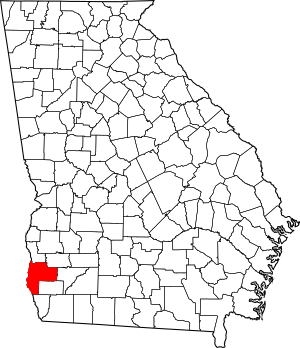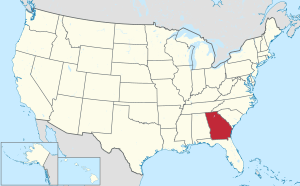Early County, Georgia facts for kids
Quick facts for kids
Early County
|
|
|---|---|

Early County Courthouse in Blakely
|
|

Location within the U.S. state of Georgia
|
|
 Georgia's location within the U.S. |
|
| Country | |
| State | |
| Founded | 1818 |
| Named for | Peter Early |
| Seat | Blakely |
| Largest city | Blakely |
| Area | |
| • Total | 516 sq mi (1,340 km2) |
| • Land | 513 sq mi (1,330 km2) |
| • Water | 3.8 sq mi (10 km2) 0.7%% |
| Population
(2020)
|
|
| • Total | 10,854 |
| • Density | 21/sq mi (8/km2) |
| Time zone | UTC−5 (Eastern) |
| • Summer (DST) | UTC−4 (EDT) |
| Congressional district | 2nd |
Early County is a place in the southwest part of Georgia, right on the border with Alabama. It's a type of local government area called a county. In 2020, about 10,854 people lived here.
The main town and center of the county is Blakely. This is where you'll find the Early County Courthouse. Early County was officially created on December 15, 1818. It was named after Peter Early, who was the 28th Governor of Georgia. The Chattahoochee River forms the western border of the county, separating it from Alabama.
Contents
History of Early County
Early County has a rich history, from ancient times to more recent events. You can explore some of its past at local attractions.
Ancient Mounds and Early Peoples
One important historical site is the Kolomoki Mounds. This is a park that protects large mounds built by indigenous peoples long ago. These mounds were created by the Woodland culture, a group of Native Americans, over 1700 years ago. They built them between 350 CE and 600 CE.
The Kolomoki Mounds form one of the biggest mound sites in the United States. It's the largest one in Georgia. The site includes mounds used for burials and special ceremonies. The ancient people were very clever. They built the mounds so they would line up with the sun during the spring equinox and summer solstice. This shows how they understood the sky and their place in the world.
Native American Lands and Changes
Before European settlers arrived, the area of Early County was home to the historic Creek Indian peoples. They lived especially along the Chattahoochee River. Later, European-American settlers moved into the area. This led to the displacement of the Creek people during the first half of the 1800s.
Historic Structures
Early County also has some interesting old buildings. The Cohelee Creek Bridge is the southernmost covered bridge that is still standing today. Also, one of the last wooden flagpoles from the American Civil War era can be found at the historic courthouse in downtown Blakely.
Geography of Early County
Early County covers a total area of about 516 square miles. Most of this is land, about 513 square miles. A small part, about 3.8 square miles (or 0.7%), is water.
Rivers and Basins
The northeastern and eastern parts of Early County, especially east of Blakely, are located in the Spring Creek sub-basin. This sub-basin is part of the larger ACF River Basin. The ACF River Basin includes the Apalachicola, Chattahoochee, and Flint Rivers. The western part of the county is in the Lower Chattahoochee River sub-basin, which is also part of the ACF River Basin.
Major Highways
 U.S. Route 27
U.S. Route 27
 U.S. Route 27 Business
U.S. Route 27 Business U.S. Route 84
U.S. Route 84 State Route 1
State Route 1 State Route 1 Business
State Route 1 Business State Route 38
State Route 38 State Route 39
State Route 39 State Route 45
State Route 45 State Route 62
State Route 62 State Route 62 Bypass
State Route 62 Bypass State Route 200
State Route 200 State Route 216
State Route 216 State Route 273
State Route 273 State Route 273 Spur
State Route 273 Spur State Route 370
State Route 370
Neighboring Counties
Early County shares borders with several other counties:
- Clay County (north)
- Calhoun County (northeast)
- Baker County (east)
- Miller County (southeast)
- Seminole County (south or east)
- Houston County, Alabama (southwest)
- Henry County, Alabama (west)
Communities in Early County
Early County has several towns and communities where people live.
Cities
Town
Census-designated place
Other Unincorporated Communities
Population and People
| Historical population | |||
|---|---|---|---|
| Census | Pop. | %± | |
| 1820 | 768 | — | |
| 1830 | 2,051 | 167.1% | |
| 1840 | 5,444 | 165.4% | |
| 1850 | 7,246 | 33.1% | |
| 1860 | 6,149 | −15.1% | |
| 1870 | 6,998 | 13.8% | |
| 1880 | 7,611 | 8.8% | |
| 1890 | 9,792 | 28.7% | |
| 1900 | 14,828 | 51.4% | |
| 1910 | 18,122 | 22.2% | |
| 1920 | 18,983 | 4.8% | |
| 1930 | 18,273 | −3.7% | |
| 1940 | 18,679 | 2.2% | |
| 1950 | 17,413 | −6.8% | |
| 1960 | 13,151 | −24.5% | |
| 1970 | 12,682 | −3.6% | |
| 1980 | 13,158 | 3.8% | |
| 1990 | 11,854 | −9.9% | |
| 2000 | 12,354 | 4.2% | |
| 2010 | 11,008 | −10.9% | |
| 2020 | 10,854 | −1.4% | |
| 2023 (est.) | 10,563 | −4.0% | |
| U.S. Decennial Census 1790-1880 1890-1910 1920-1930 1930-1940 1940-1950 1960-1980 1980-2000 2010 2020 |
|||
| Race / Ethnicity (NH = Non-Hispanic) | Pop 2000 | Pop 2010 | Pop 2020 | % 2000 | % 2010 | % 2020 |
|---|---|---|---|---|---|---|
| White alone (NH) | 6,159 | 5,250 | 4,813 | 49.85% | 47.69% | 44.34% |
| Black or African American alone (NH) | 5,901 | 5,441 | 5,534 | 47.77% | 49.43% | 50.99% |
| Native American or Alaska Native alone (NH) | 23 | 34 | 31 | 0.19% | 0.34% | 0.29% |
| Asian alone (NH) | 23 | 37 | 47 | 0.19% | 0.34% | 0.43% |
| Pacific Islander alone (NH) | 7 | 2 | 0 | 0.06% | 0.02% | 0.00% |
| Other race alone (NH) | 5 | 5 | 11 | 0.04% | 0.05% | 0.10% |
| Mixed race or Multiracial (NH) | 84 | 68 | 232 | 0.68% | 0.62% | 2.14% |
| Hispanic or Latino (any race) | 152 | 171 | 186 | 1.23% | 1.55% | 1.71% |
| Total | 12,354 | 11,008 | 10,854 | 100.00% | 100.00% | 100.00% |
As of the 2020 United States census, there were 10,854 people living in Early County. These people made up 4,074 households, and 2,659 families.
Education in Early County
The Early County School District is in charge of public schools in the county. It teaches students from pre-school all the way up to twelfth grade.
The district has:
- Early County Elementary School
- Early County Middle School
- Early County High School
There are 156 full-time teachers in the district, helping to educate over 2,764 students.
See also
 In Spanish: Condado de Early para niños
In Spanish: Condado de Early para niños

